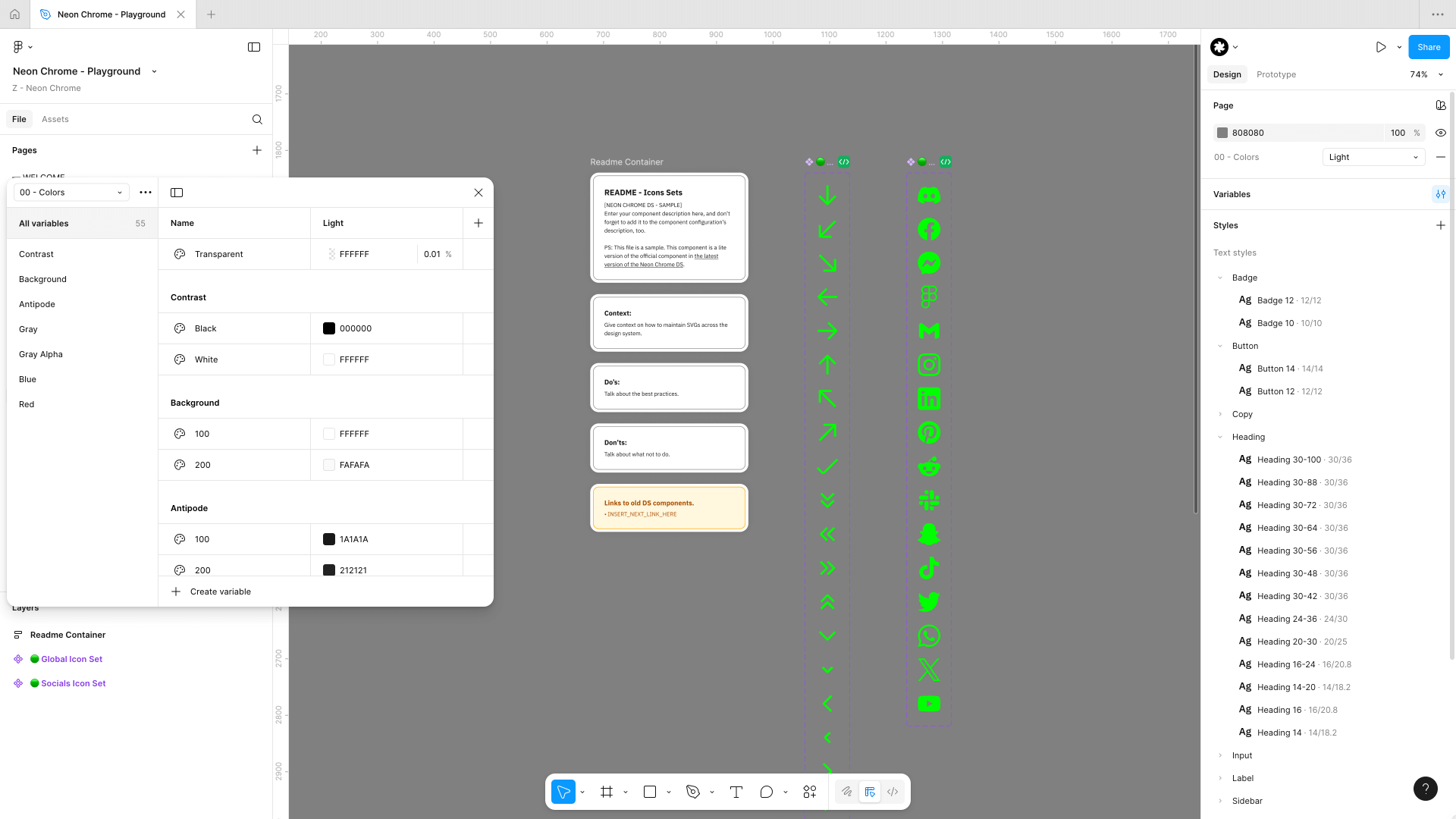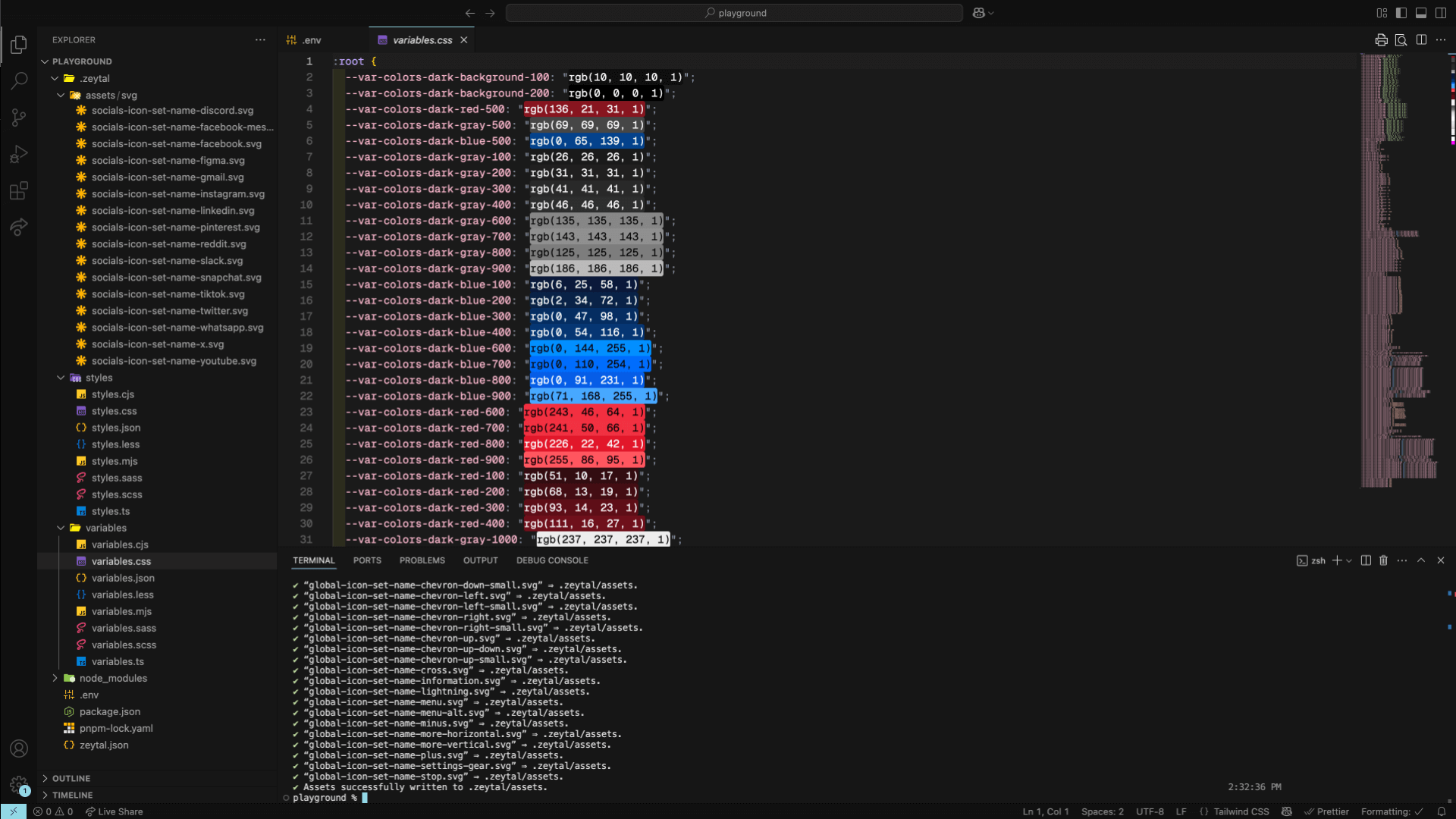Introduction
Welcome to the Zeytal documentation.
What’s Zeytal?
Zeytal is a free, open-source, and privately maintained CLI tool.
It bridges the gap between your Figma designs and your web app’s code.
You use Zeytal to automatically export your Figma SVGs, extract your Figma styles and variables, and generate front-end configuration files like TailwindCSS config files.
In other words, by typing a simple command in your terminal:
terminal
pnpm zeytalThis Figma file ↓

Becomes these generated files ↓

Under the hood, Zeytal handles all the setup for extracting Figma variables, styles, and SVGs — including SVG optimization and converting styles and variables in different languages — so you don’t have to.
This allows you to focus on building your application instead of spending time trying to close the gap between design and dev.
Whether you’re an individual developer or part of a larger team, Zeytal can help you auto-generate code from any design system file, even the big ones.
Design-to-code philosophy
Zeytal’s core philosophy is cutting unnecessary complexity, simplifying workflows, and making everything intuitive.
Our mission is to eliminate technical debt.
We see three levels of action to reduce tech debt:
- Education
- Standardization
- Automation
There are:
- things you can educate about, standardize, and automate
- things you can only educate about and standardize
- things you can only educate about
With Zeytal, our approach is:
- Automate everything that can and should be automated
- Follow industry standards, standardize where possible, and educate along the way
- Educate when automation or standardization isn’t possible
How we apply this philosophy
We’re not here to reinvent the wheel.
That’s why:
- No bloated management layers — our dashboard is minimal and built for real use
- Extracted assets (SVGs) keep the exact names they have in Figma; they’re only kebab-cased
- Extracted styles keep their Figma names and respect their nested structures; they’re only kebab-cased or camel-cased depending on the extraction languages you chose
- Extracted variables keep their Figma names and respect their nested structures; they’re only kebab-cased or camel-cased depending on your chosen extraction languages.
Here’s the syntax we follow:
/* Syntax for assets */
dashed-name.svg
/* Syntax for variables */
var-collection-mode-name: value;
/* Syntax for styles */
style-name: value;For example:
- The frame of a variant named
Name=Arrow Downin anIconcomponent in Figma becomesicon-name-arrow-down.svgonce extracted and optimized. - The style
Heading/Heading 36in Figma becomesstyle-heading-heading-36in your generated style files. - The variable
Background/100in a collection namedColorswithLightandDarkmodes in Figma becomesvar-colors-light-background-100andvar-colors-dark-background-100in your generated variable files.
This way, when you use assets, styles, and variables in your code, there’s no guesswork — just import and use them exactly as named in Figma.
You can learn more about the specifics of the files you generate in the related section of the docs.
Main features
Some of the main Zeytal features include:
- Figma data fetching
- SVGs extraction and optimization
- Figma styles and variables extraction
- Figma styles and variables translation (CSS, TS, JS, JSON, SCSS, etc.)
- TailwindCSS config files generation
For the complete list of features, see the features list page.
Starting your journey
This tutorial is framework agnostic but Zeytal supports many frontend configurations and tools. As you go through the docs, we will provide specific instructions for these tools.
If you don’t find what you need, give us feedback and we’ll update them.
While some of our instructions use the dashboard, the rest use Zeytal CLI to carry out your Figma files data extraction. In this tutorial, look for the “Zeytal CLI” section for the CLI steps.
Pre-requisite knowledge
Although our docs are designed to be beginner-friendly, to get the most out of our docs, it’s recommended that you have a basic understanding of Figma and JS dev environments.
We’ll provide links to relevant documentation whenever we introduce a new concept.
Next steps
Learn about all the cool things you can do with Zeytal.